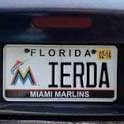They both used to be
losers in the NL East. Now one of them is still a loser …
During the post-season,
I've been gathering data.
Of the top eight batters and four starters:
The Mets have built their
team like this: 7 from drafts, one from the amateur free agent
(meaning basically smart draft option), three trades and one free
agent.
The Marlins have six from
the draft (one being Rule 5: Bour), five from trades and 1 amateur free agent.
I was expecting that I'd
see the Mets with a lot more draft picks, but now let's break it
down.
First of all, what didn't
we see? The Marlins wasted money on two free agents – Salty at
catcher and Morse at 1B – that weren't part of the end-of-year
roster I'm using for this comparison.
What's more, the Marlins dumped two young pitchers –
Andrew Heaney, 24, who ended up in Anaheim 6-4 3.49, and Anthony
DeSclafani, 25, with the Reds 9-13 4.05.For these two young two
young pitchers we got two old pitchers – now gone – and Dee
Gordon, an All-Star second baseman.
The rumblings were that
DeSclafani and Heaney in brief appearances with Marlins in 2014
hadn't been as good as hoped, and so they were better off dumped. So
...maybe the drafting folks weren't as good as they should have been.
As the Marlins give away young
pitchers, what did the Mets do? They dumped a successful older
pitcher, Dickey, and picked up a super young pitcher, Syndergaard, as
well as a young starting catcher, d'Arneau.
And this
year, in a last-minute deal that sent Mets
prospects soaring, they obtained Yoenis Cespedes from the Tigers for
two young pitching prospects. Imagine: They have four young fabulous
pitchers in their rotation and they still had so much depth in the
farm system that they could give up two more pitchers for a
(temporary?) super-star.
Another contrast that
with the Marlins: Two young pitchers Eovaldi (14-3, 4.03) and German
(injured), a super prospect in minors, were traded for Prado.
Free agents: The Mets
picked up Granderson, a great addition; the Marlins picked up guys
like Salty who didn't even make it to the end of the season.
Quality drafting: Mets
pitchers Harvey, deGrom and Matz. Marlins drafted pitchers:
Fernandez, Koehler. Think Mets would trade one of those guys for
Koehler, who's in the mix only because the Marlins dumped other
pitchers?
Marlins management could say the team would have done better if Stanton wasn't injured, but in fact their play improved in last part of season without him. AND Wright, the Met's traditional star, missed a lot of the season with a gimpy back.
Marlins management could say the team would have done better if Stanton wasn't injured, but in fact their play improved in last part of season without him. AND Wright, the Met's traditional star, missed a lot of the season with a gimpy back.
"Show Me the Money"
So let's look at the
money. At start of season, the Mets were spending $101 million on
payroll versus Marlins $68 million.
The Marlins have less to
spend because they get less money from fans. The Mets TV contract
must be a ton larger than the Marlins (nothing can be done about
that). The Mets had attendance of 2.6 milion in 2015, compared to 1.7
million for the Marlins. This translates into less money.
How much less. On the
web, you'll see that the average Met ticket price is $25.30 versus
the Marlins $28.96.
But I'm thinking that
this must be list price – the way that hospitals have list prices
that nobody pays.
In fact, I myself attended eight games at an
average cost of $12.50, because half the games I got in free as an
old fart. I'll bet the Mets don't give old farts free admission.
Loudly Ticking Time Bomb: Stanton
Now, let's get to the
worst part. There's a loudly ticking time bomb. The Marlins – and
Stanton – agreed to backload the $325 million contract. This year,
he was paid a mere $6.5 million – with the idea that front office
would have enough money to start building a winner, drawing fans to
the ballpark, creating more revenue, for better ball players, etc.
So
by going after Latos and Morse et al, they've basically blown a year.
Next year, Stanton costs
$9 million, according a Forbes report. In 2017, it's $14.5 million
and by 2018, it's up to $25 million.
The clock is certainly
ticking on building a winner. Forbes noted earlier this year: “Of
the past 46 major league playoff teams, only nine spent more than 17
percent of their payroll on a single player. Stanton will currently
eclipse those percentages.”You do the math.
